Blog & Latest Updates
Fly Fishing Articles
Insects by Common Name


Mayfly Family Baetidae (Blue-Winged Olives)
Taxonomic Navigation -?-
Kingdom
Animalia (Animals)
» Phylum
Arthropoda (Arthropods)
» Class
Insecta (Insects)
» Order
Ephemeroptera (Mayflies)
» Family Baetidae (Blue-Winged Olives)
11 genera aren't included.
Common Name
| Match | Common Name |
| Blue-Winged Olives |
This is page 7 of specimens of Baetidae. Visit the main Baetidae page for:
- The behavior and habitat of Baetidae.
- 10 underwater pictures of Baetidae.
Pictures of 103 Mayfly Specimens in the Family Baetidae:
Female Baetis (Blue-Winged Olives) Mayfly Dun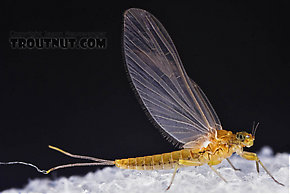 View 4 PicturesI'm guessing this specimen is in the genus Acerpenna because of the very sharp costal process (
View 4 PicturesI'm guessing this specimen is in the genus Acerpenna because of the very sharp costal process (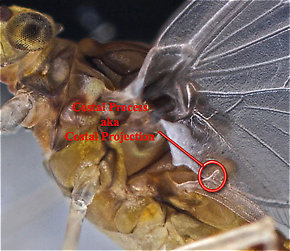 Costal process: A bump or point sticking up from the front margin of an insect's wing, usually the rear wing of certain mayflies. It is sometimes called a costal projection.) on her hind wing. I'm guessing pygmaea because it is the most common species.
Costal process: A bump or point sticking up from the front margin of an insect's wing, usually the rear wing of certain mayflies. It is sometimes called a costal projection.) on her hind wing. I'm guessing pygmaea because it is the most common species.
Editor note: Not Acerpenna. This is most likely Baetis. See comments on this male specimen for rationale. Also compare with the female specimen associated with it.
 View 4 PicturesI'm guessing this specimen is in the genus Acerpenna because of the very sharp costal process (
View 4 PicturesI'm guessing this specimen is in the genus Acerpenna because of the very sharp costal process (
The costal process of a Baetidae dun.
Editor note: Not Acerpenna. This is most likely Baetis. See comments on this male specimen for rationale. Also compare with the female specimen associated with it.
Collected July 1, 2005 from the Bois Brule River in Wisconsin
Added to Troutnut.com by Troutnut on April 22, 2006
Added to Troutnut.com by Troutnut on April 22, 2006
Baetis (Blue-Winged Olives) Mayfly Nymph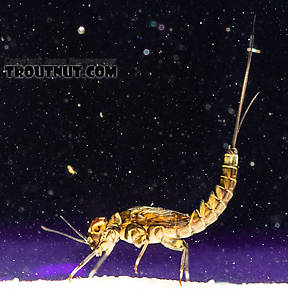 View 5 Pictures
View 5 Pictures
 View 5 Pictures
View 5 PicturesCollected June 13, 2019 from the South Fork Snoqualmie River in Washington
Added to Troutnut.com by Troutnut on June 14, 2019
Added to Troutnut.com by Troutnut on June 14, 2019
Female Baetidae (Blue-Winged Olives) Mayfly Dun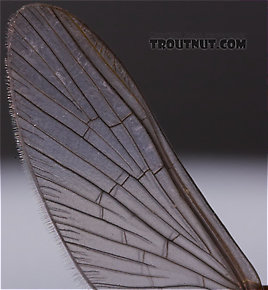 View 7 PicturesThis specimen was collected on the same trip as a similar dun.
View 7 PicturesThis specimen was collected on the same trip as a similar dun.
 View 7 PicturesThis specimen was collected on the same trip as a similar dun.
View 7 PicturesThis specimen was collected on the same trip as a similar dun.Collected May 28, 2005 from the Namekagon River in Wisconsin
Added to Troutnut.com by Troutnut on May 24, 2006
Added to Troutnut.com by Troutnut on May 24, 2006
Male Baetidae (Blue-Winged Olives) Mayfly Nymph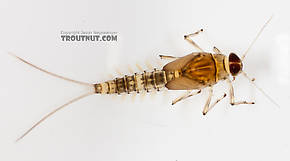 View 8 Pictures
View 8 Pictures
 View 8 Pictures
View 8 PicturesCollected July 17, 2011 from the Gulkana River in Alaska
Added to Troutnut.com by Troutnut on July 20, 2011
Added to Troutnut.com by Troutnut on July 20, 2011
Male Baetidae (Blue-Winged Olives) Mayfly Spinner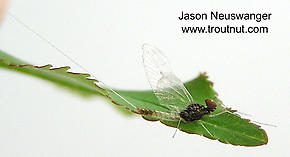 View 4 PicturesI love the shape of this guy's eyes.
View 4 PicturesI love the shape of this guy's eyes.
 View 4 PicturesI love the shape of this guy's eyes.
View 4 PicturesI love the shape of this guy's eyes.Collected May 24, 2004 from unknown in Wisconsin
Added to Troutnut.com by Troutnut on January 25, 2006
Added to Troutnut.com by Troutnut on January 25, 2006
Baetis (Blue-Winged Olives) Mayfly Nymph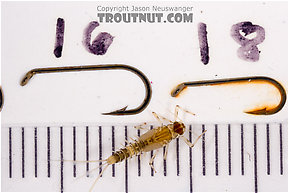 View 5 Pictures
View 5 Pictures
 View 5 Pictures
View 5 PicturesCollected April 1, 2007 from Mystery Creek #62 in New York
Added to Troutnut.com by Troutnut on April 3, 2007
Added to Troutnut.com by Troutnut on April 3, 2007
Male Baetis bicaudatus (BWO) Mayfly Nymph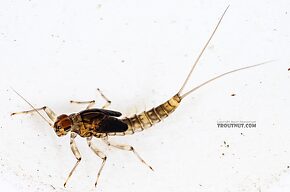 View 7 PicturesThis specimen was collected along with a female which was quite a bit larger, different in color, but otherwise seemed the same morphologically.
View 7 PicturesThis specimen was collected along with a female which was quite a bit larger, different in color, but otherwise seemed the same morphologically.
 View 7 PicturesThis specimen was collected along with a female which was quite a bit larger, different in color, but otherwise seemed the same morphologically.
View 7 PicturesThis specimen was collected along with a female which was quite a bit larger, different in color, but otherwise seemed the same morphologically.Collected April 12, 2021 from Holder Creek in Washington
Added to Troutnut.com by Troutnut on April 13, 2021
Added to Troutnut.com by Troutnut on April 13, 2021
Diphetor hageni (Little Blue-Winged Olive) Mayfly Nymph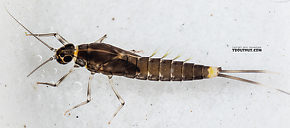 View 6 Pictures
View 6 Pictures
 View 6 Pictures
View 6 PicturesCollected July 25, 2019 from Mystery Creek #249 in Washington
Added to Troutnut.com by Troutnut on July 26, 2019
Added to Troutnut.com by Troutnut on July 26, 2019
Female Baetis bicaudatus (BWO) Mayfly Nymph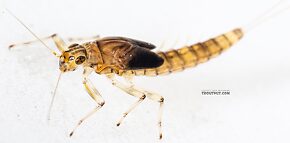 View 12 PicturesI collected this one along with a male that was quite a bit smaller but equally ready to emerge in mid April.
View 12 PicturesI collected this one along with a male that was quite a bit smaller but equally ready to emerge in mid April.
I spent (Spent: The wing position of many aquatic insects when they fall on the water after mating. The wings of both sides lay flat on the water. The word may be used to describe insects with their wings in that position, as well as the position itself.) quite a while on the identifications, because they really don't look very much like the Baetis bicaudatus nymph I caught last year in Idaho. However, the presence of hind wing pads (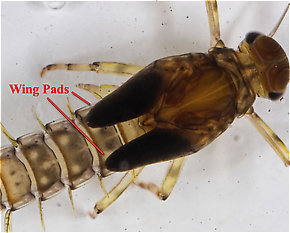 Wing pad: A protrusion from the thorax of an insect nymph which holds the developing wings. Black wing pads usually indicate that the nymph is nearly ready to emerge into an adult.) rules out Acentrella turbida, the lack of a fringe of long setae (Seta: Little hairs on insects.) on the tibiae (
Wing pad: A protrusion from the thorax of an insect nymph which holds the developing wings. Black wing pads usually indicate that the nymph is nearly ready to emerge into an adult.) rules out Acentrella turbida, the lack of a fringe of long setae (Seta: Little hairs on insects.) on the tibiae (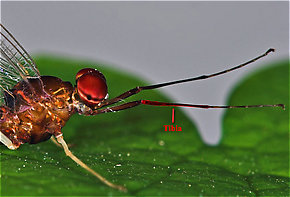 Tibia: A middle segments in the leg of an insect, located between the femur and the tarsus.) rules out Acentrella insignificans, range rules out Heterocloeon and Iswaeon, and the thumb-like projection on the labial palp (
Tibia: A middle segments in the leg of an insect, located between the femur and the tarsus.) rules out Acentrella insignificans, range rules out Heterocloeon and Iswaeon, and the thumb-like projection on the labial palp (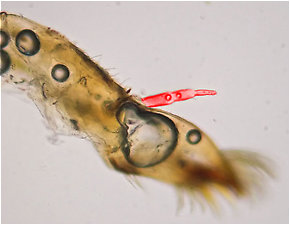 Palp: A long, thin, often segmented appendage which can protrude from certain insect mouth parts such as the maxillae. Also known as the < />palpus.) points to Baetis. Thus, Baetis bicaudatus is a fairly confident ID, and it's not too surprising that it looked different from my previous specimen because bicaudatus is thought to be a species complex with multiple types that haven't been fully sorted out yet.
Palp: A long, thin, often segmented appendage which can protrude from certain insect mouth parts such as the maxillae. Also known as the < />palpus.) points to Baetis. Thus, Baetis bicaudatus is a fairly confident ID, and it's not too surprising that it looked different from my previous specimen because bicaudatus is thought to be a species complex with multiple types that haven't been fully sorted out yet.
The microscope pictures for this specimen aren't from the same exact nymph, but a mixture of a few others of the same kind that I didn't mind dissecting.
 View 12 PicturesI collected this one along with a male that was quite a bit smaller but equally ready to emerge in mid April.
View 12 PicturesI collected this one along with a male that was quite a bit smaller but equally ready to emerge in mid April.I spent (Spent: The wing position of many aquatic insects when they fall on the water after mating. The wings of both sides lay flat on the water. The word may be used to describe insects with their wings in that position, as well as the position itself.) quite a while on the identifications, because they really don't look very much like the Baetis bicaudatus nymph I caught last year in Idaho. However, the presence of hind wing pads (

The wing pads on this final instar Baetidae mayfly nymph are extremely dark.

The tibia of this Isonychia bicolor mayfly spinner is highlighted in red.

The palp on the maxilla of an Ephemerella nymph (detached and photographed under a microscope) is highlighted in red here.
The microscope pictures for this specimen aren't from the same exact nymph, but a mixture of a few others of the same kind that I didn't mind dissecting.
Collected April 12, 2021 from Holder Creek in Washington
Added to Troutnut.com by Troutnut on April 13, 2021
Added to Troutnut.com by Troutnut on April 13, 2021
Female Callibaetis ferrugineus (Speckled Spinner) Mayfly Spinner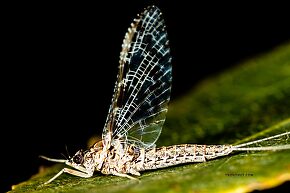 View 9 Pictures
View 9 Pictures
 View 9 Pictures
View 9 PicturesCollected September 4, 2020 from Silver Creek in Idaho
Added to Troutnut.com by Troutnut on September 18, 2020
Added to Troutnut.com by Troutnut on September 18, 2020
Top 10 Fly Hatches
Top Gift Shop Designs
Eat mayflies.
Top Insect Specimens
Miscellaneous Sites
Troutnut.com is copyright © 2004-2024 Jason
Neuswanger (email Jason). See my FAQ for information about use of my images.
 privacy policy
privacy policy
